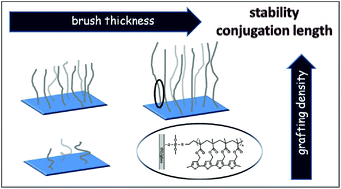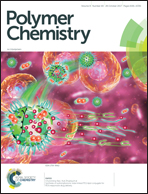The grafting density and thickness of polythiophene-based brushes determine the orientation, conjugation length and stability of the grafted chains†
Abstract
A self-templating surface-initiated technique that combines surface-initiated atom transfer radical polymerization (SI-ATRP) and oxidative polymerization for the fabrication of conjugated polythiophene-based brushes in a ladder-like architecture was developed here. The selective cleaving of polymer chains by using a tetrabutylammonium fluoride agent enabled the formation of brushes with various grafting densities but with the same polymerization degrees in order to elucidate the effect of the brush thickness and grafting density on the stability and optical properties of the conjugated brushes. Poly(3-methylthienyl methacrylate) (PMTM) brushes with a higher grafting density subjected to the oxidative polymerization with FeCl3 resulted in polythiophene chains with a longer effective conjugation and higher (photo)stability than the less densely grafted brushes. The effective conjugation length was also found to increase with the brush thickness reaching ca. 90–100 mers (as determined using UV-VIS spectroscopy; λmax = 528 nm) for 80 nm thick brushes. These observations supported by grazing angle FTIR measurements indicated stretched conformation of the ladder-like structures in relation to the perpendicular orientation with respect to the surface due to the supporting role of the surface-grafted chains. Importantly, such brushes exhibited remarkable (photo)stability during storage under ambient conditions as opposed to classical polymer films. The ladder-like architecture of polythiophene-based brushes was found to ensure the extended conjugation length at a high grafting density of the conjugated polymer chains that is necessary for the fabrication of highly oriented and stable platforms of molecular wires.



 Please wait while we load your content...
Please wait while we load your content...